
Traditional communication channels like email and phone calls hold a strong ground in the business communication landscape. However, there’s another powerful yet often overlooked tool that helps businesses connect with their customers efficiently and effectively. I’m talking about SMS, i.e., Short Message Service in business communication. This blog takes you through the deeper aspects of SMS for business communication, highlighting its features and benefits along with the best practices to help your business succeed.
What is SMS for Business Communication?
SMS communication has been a part and parcel of our daily lives for a long time. Likewise, it is also used extensively in business setups for marketing, customer service, and internal communication. It comes as a direct, personalized, and timely medium to engage with customers and build relationships. In contrast to other communication mediums such as email, SMS messages offer a near-instantaneous delivery rate and are also typically read within a few minutes of being sent.
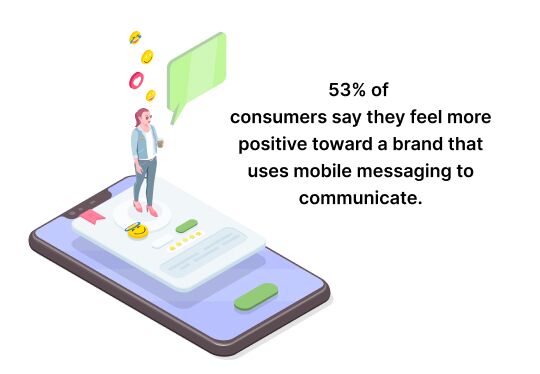
Unlike personal SMS messaging, SMS in business communication often involves using specialized software. The approach is known as Application-to-Person (A2P) SMS. Such software helps businesses send bulk SMS messages, automate responses, and integrate with other communication systems.
What are Different Ways to Use Text Messaging in Business Communication?

As of 2023, there were almost 8.9 billion mobile phone subscriptions worldwide. That even exceeds the global population of 7.9 billion! ( Source )
The widespread availability of mobile phones worldwide creates a significant opportunity for businesses to leverage SMS for effective communication.
There are several ways in which SMS can be utilized to boost business communication. Let’s take a look at some of the most common use cases.
Customer Support
The customer support domain requires providing quick responses to customer inquiries and resolving issues promptly. SMS offers a hassle-free channel for customers to conveniently text their issues and receive prompt support from the business.
Suppose, a customer asks about a product’s technical glitch by sending a text message to the business. Here’s an example:
Customer: “Hey, I’m having trouble connecting my [product name] to my [device name]. I’ve tried [steps]. Any suggestions?”
Business: “Hi [Customer Name], thanks for reaching out. We’re sorry to hear about the issue. Could you please confirm if [specific detail about the issue] is happening? Also, have you tried [alternative solution]?”
Customer: “Yes, [specific detail]. I’ve tried [alternative solution] but it didn’t work.”
Business: “Thanks for the information. Please expect a follow-up message within the next 24 hours. In the meantime, check out our FAQ section at [link].”
Marketing and Promotions
SMS can be used to send targeted discounts, offers, contests, and giveaways related information to customers. For example, businesses can create a sense of urgency and exclusivity by offering limited-time discounts, flash sale coupons, etc.
Suppose a footwear brand sends a text message to its customers who recently purchased running shoes. The message offers customers an exclusive discount on complementary products like a pair of running socks. Following such a marketing strategy can help the business drive sales, build customer loyalty, and improve the effectiveness of its marketing efforts.
For example, an SMS informing customers about the flash sale could be like this:
“Last chance! Get 15% off your next purchase. Offer ends tonight at midnight. Use code LAST15.”
Or
An SMS conveying customers about a new product launch could be like this:
“Introducing our new [Product Name]! Get a sneak peek and pre-order now. Use code NEW[Product Name] for a special discount.”
Appointment Reminders
Another excellent usage of SMS in business is sending appointment reminders via text messages. By integrating SMS functionality with the existing appointment scheduling software, a business can automatically send SMS reminders to customers at a specified time before their appointment. For example, sending the reminder a day before the appointment.
Moreover, the SMS reminders can be customized to include appointment-related information such as date, time, and reason for visit.
By doing so, businesses can reduce the likelihood of no-shows and increase the percentage of customers showing up for their appointments. Also, the need for manual follow-up calls gets eliminated, thus saving time and resources for the business as well as the customers. For instance, a gynecology clinic can send automated reminders to patients a day before their scheduled appointment, increasing their attendance.
The SMS can be like this:
“Hi [Patient Name], this is a reminder for your appointment tomorrow at [Time] with Dr. [Doctor’s Name]. Please let us know if you need to reschedule.”
Order Confirmations and Delivery Status Updates
E-commerce businesses can also utilize SMS to keep their customers informed about orders through SMS notifications such as confirmation about order, shipping and delivery. When customers receive timely and relevant information about their orders, they are certainly less anxious and more satisfied.
For example, an online store sends an order confirmation text message and provides real-time updates regarding order delivery through SMS. This also helps in reducing the number of inquiries the e-commerce business receives about shipping and delivery.
An order shipping confirmation and tracking SMS could be like this:
“Your order has shipped! Tracking number: [Tracking Number]. You can track your package here: [Tracking link]”
Two-Factor Authentication
Secure login access is another useful area where SMS can play a crucial role. SMS-based 2FA is a common security implementation where one factor is a user’s password and the second factor is a one-time password (OTP). This OTP is time-sensitive and is sent via SMS to the user’s registered mobile number. Only upon entering the correct OTP, the access is approved to the user.
This way of sending verification codes via SMS to authenticate users, the security of the login process for any account can be enhanced. So if one of the security factors gets compromised, an extra layer of protection prevents unauthorized access.
Have a look at this example, where a bank makes use of 2FA to protect user accounts:
- Step 1: A user enters their username and password to log in to an online banking account.
- Step 2: The bank sends a unique, time-limited code (OTP) via SMS to the user’s registered mobile number.
- Step 3: The user enters the code into the login form.
- Step 4: If the code is correct, the user is granted access to their account.
Internal Business Communication
SMS can also be an extremely handy communication tool when it comes to sharing information within a business organization. Urgent announcements, meeting reminders, company updates, etc., can be sent via SMS messages to employees and stakeholders.
While SMS ensures that messages are delivered instantly, it also proves to be cost-effective than traditional communication methods like phone calls or printed notices. Moreover, it allows for immediate feedback and responses, ensuring real-time engagement.
Advantages of SMS in Business Communication
SMS has a High Open Rate
Compared to other communication channels, SMS boasts a quite impressive open rate. While it is just 20% for email, the open rate for SMS goes exceptionally high at 98%. Such a percentage suggests that your text messages have a high likelihood of being seen and acted upon.
Text Messages are Delivered Immediately
The time it takes for an SMS message to reach from its sender to the receiver’s device is just a few seconds. Such instant delivery makes SMS an ideal tool for time-sensitive communications.
Messages can be Personalized
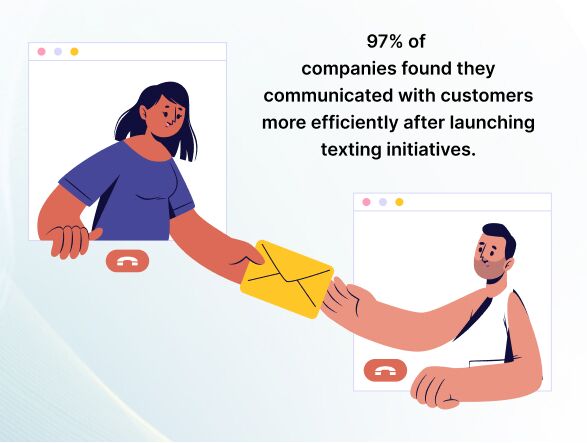
Businesses need to connect with customers directly to build stronger relationships. SMS allows personalized communication as businesses can include the customer’s name and tailored content based on their past interactions and preferences.
SMS is Cost-Effective
SMS is a cost-effective communication tool. The cost of sending bulk SMS is often cheaper than other marketing methods like direct mail or print media.
Texts Offer a Global Reach
We all know that SMS is a globally accessible communication medium. Regardless of the device and location, SMS offers a simple and effective way to connect with people around the world. Moreover, text messages don’t rely on data plans. Any mobile device with a network connection can send and receive text messages. Also, SMS can be used to send messages in various languages and character sets, making it suitable for international communication.
What are the Features of a Business SMS Solution?
Business SMS solutions come with a range of features designed to enhance communication. Let’s take a look at some of the key features of a business SMS solution:
Bulk Messaging
This feature enables businesses to send a single message to a large number of recipients simultaneously. Bulk messaging is ideal for marketing campaigns or important announcements. The benefits of using bulk messaging are that it saves time, resources and reaches a wide audience efficiently. For example, a retail business sends a promotional code to all its customers for the ongoing flash sale in one go.
Message Scheduling Automation
Automation can be a game changer when it is about handling repetitive communication tasks like order confirmations, password verifications, appointment reminders, etc. This feature allows businesses to schedule their messages to be sent at specific times or trigger messages based on certain actions or events.
Automation reduces manual effort and ensures timely communication. Once you have the right SMS software that enables you to automate these tasks, you can experience a significant boost in your productivity.
Two-Way Communication
This function enables customers to respond to your messages, facilitating interactive communication and better customer engagement. For example, a customer support team uses SMS to assist customers with their issues.
Analytics and Reporting
With the help of analytics and reporting tools in SMS software, a business can track the performance of their SMS campaigns, measure ROI, and refine their strategies.
Here’s a simple example: A business sends out a promotional SMS campaign and starts analyzing the results to determine its effectiveness and identify areas for improvement.
Integration
Through this feature, businesses can integrate SMS with other business systems like CRM and email marketing platforms, customer support software, etc. This helps in streamlining workflows, seamless communication, and data management. Imagine a business integrating an SMS solution with CRM to automate sending tailored messages based on customer data.
What Phone Numbers Can You Use in Business SMS?
When it comes to SMS communication in business, there are various options to choose from. Let’s explore these options, one by one:
Short Codes
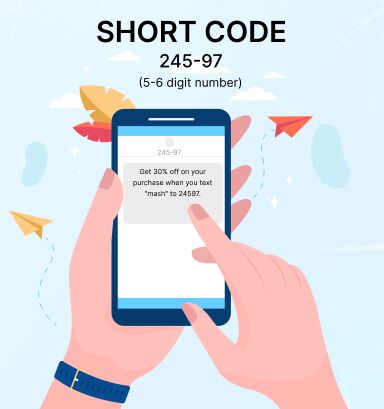
Short codes are 4 to 9-digit numbers used for high-volume messaging. The usage of such codes is usually done for marketing campaigns, bulk messaging, and mass notifications such as alerts and contests. Depending upon the number of messages a business is sending and the data rates of the network provider, short codes often cost expensive. An example of a short code can be 855-SHOP-NOW.
Long Codes
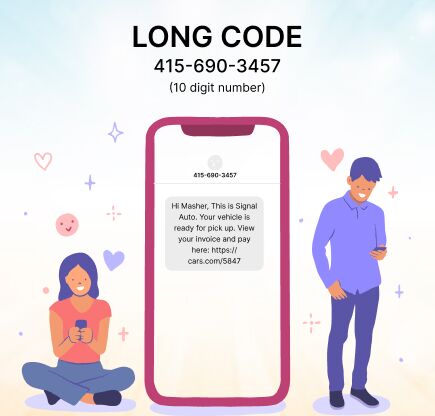
Long codes are standard 10-digit phone numbers suitable for low-volume messaging and two-way communication. In the context of business communication, long codes are often used for customer support. A prerequisite to use long codes for SMS communication is that the number must be registered to send business communication, wherein the registration process usually takes a couple of days or weeks. An example of a long code is (123) 456-7890.
Toll-Free Phone Numbers
Toll-free numbers are also long-form numbers (often 10-digit numbers), and they usually start with a prefix such as 800 or 888. Toll-free numbers allow customers to send and receive messages without incurring charges, enhancing customer convenience. Another upside of toll-free numbers is that they appear more professional than long codes.
10DLC
10DLC stands for 10-Digit Long Code. These phone numbers are regular phone numbers used for sending SMS messages on a larger scale. They are often used by businesses to communicate with their customers. A 10DLC number can look like this – +1 555 555 5555.
Dedicated Numbers
Dedicated numbers are exclusively assigned to your business, providing a consistent point of contact and improving brand recognition. However, these numbers can be used for various purposes such as support, sales, and marketing. It is important to mention that these numbers are not specifically designed for high-volume SMS campaigns. A simple example of a dedicated number is (555) 555-5555.
Choosing the Right Number – SMS for Business Communication
Probably you’re thinking about which phone number is best for SMS communication in business, right? Well, consider these factors and make an appropriate choice:
- The volume of messages you expect to send
- Your target audience
- Your brand image
For high-volume messaging or marketing campaigns, short codes may be the best option. For personalized customer support or two-way communication, long codes or toll-free numbers might be more suitable. Dedicated numbers are ideal for businesses that want to establish a strong brand identity and provide a consistent point of contact.
Texting for Business Communication vs Other Communication Channels
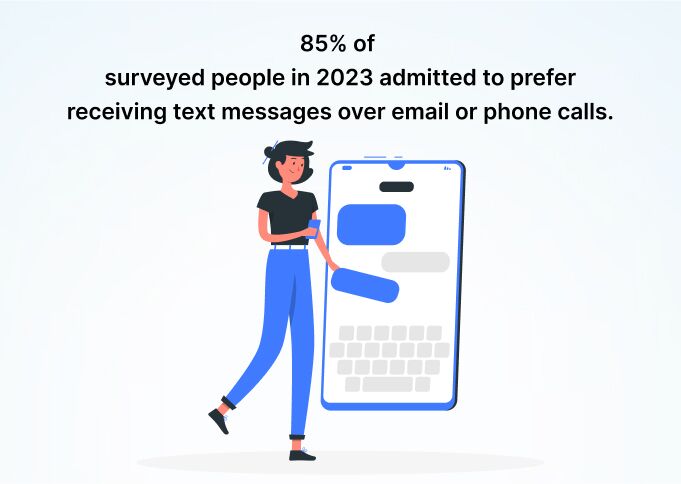
While email is effective for detailed communication and documentation, SMS offers immediacy and higher open rates, making it better for urgent or time-sensitive messages.
Phone Calls

Phone calls provide a personal touch but can be time-consuming and disruptive. SMS offers a non-intrusive alternative, allowing recipients to respond at their convenience.
Social Media

Social media is great for public engagement, but SMS provides a direct and private channel for more personalized communication.
SMS for Business Communication Best Practices

SMS has always been a powerful tool for business communication (I’ve already mentioned the numbers). To master the art of business messaging and reap maximum benefits from this tool, here are some best practices to ensure effective and compliant SMS campaigns.
Obtain Consent From Your Customers
It is important to obtain explicit consent from recipients before sending them messages. This is because many countries follow strict regulations governing SMS marketing. Also, it is quite obvious that customers are more likely to engage with companies from whom they’ve opted to receive messages. So when you have the consent, it is ensured that you adhere to these laws, respect the privacy of your customers, and do not face penalties.
One of the simple ways to obtain consent is by including a checkbox on your website or signup form that clearly states, “I consent to receiving SMS messages from [Your Company name] about [Products/Services].”
Keep Messages Concise
SMS is all about short, clear, and concise information that comes with a character limit, usually 160 characters. So when sending messages to your customers, make sure every word focuses on essential information. Don’t include unnecessary details and jargon.
For example, instead of “We are thrilled to announce our new service launch with exclusive offers. Visit our website for more details,” say, “New service launch! Limited-time offer. Visit [link].”
Personalized Messages Make More Impact
The purpose of your messages only gets fulfilled when the recipients are able to relate themselves to the message. This is the reason why you should tailor your messages to the recipient’s interests. You can divide your audience into different segments based on their demographics, interests, purchase actions and send targeted content to each segment. Such a strategy increases the likelihood of customer engagement.
For example, if a customer recently purchased a product from your website, then you can send a follow-up message asking for product ratings or suggesting complementary products.
Use Clear Call-to-Actions
Imagine you sent a message to your customers regarding a festival discount but didn’t add any link or code that customers can use to avail the offer. Your efforts are highly likely to go in vain if you do not add a CTA, i.e., call to action. It tells them what you want them to do.
So as a best practice, use action-oriented verbs in your CTA such as “click,” “visit,” “reply,” or “download.” For example, rather than sending a text, “We have a new offer for you,” you can say, “Click here to claim your 10% discount.”
Monitor and Optimize
Your past SMS campaigns are a great opportunity for you to improvise and perform better. Make it a practice to regularly monitor your SMS campaigns and use analytics to optimize performance and improve results.
Keeping track of key metrics such as open rates, click-through rates, and conversion rates can help you measure the effectiveness of the campaigns. You may consider A/B testing to experiment with different message variations and identify what works best for your audience.
For example, if you find that some specific campaign is experiencing a low open rate, then you may try a different sending time or change the subject line.
REVE SMS Platform: A Telco-Grade SMS Solution for Your Business

A comprehensive SMS solution for companies looking for efficient and cost-effective SMS communication, the REVE SMS platform supports Application-to-Person, Person-to-Application, and Person-to-Person SMS traffic. REVE SMS brings a wide range of powerful features that can help you run successful SMS campaigns. Companies can send a wide range of message types, including promotional, bulk, transactional, and response-driven SMS. You can avail the solution either through licensing or a hosted model.
SMS for Business Communication – Key Takeaway!
SMS for business communication offers a powerful, versatile, and cost-effective way to connect with customers, employees, and stakeholders. By leveraging the advantages and features of business SMS solutions, and following best practices, businesses can enhance their communication strategies, drive engagement, and achieve better outcomes. Embrace SMS as a key component of your communication toolkit and experience the benefits of instant, direct, and personalized messaging.
Frequently Asked Questions
How can businesses collect phone numbers for SMS communication?
There are various ways in which businesses can collect phone numbers, including opt-in forms on websites, social media channels, etc.
What is an SMS API?
An SMS API allows businesses to integrate SMS messaging into their existing applications.
How can businesses personalize SMS messages?
Personalization in SMS can be achieved by including customer names, purchase history, or personalized offers in the message.
Are SMS and push notifications different?
Yes, SMS is delivered directly to the phone of the recipient via carriers. while push notifications are app-based messages sent over the internet.
How can a business improve SMS message delivery rates?
Choose a reliable SMS provider, avoid peak usage times, and optimize your content.




























